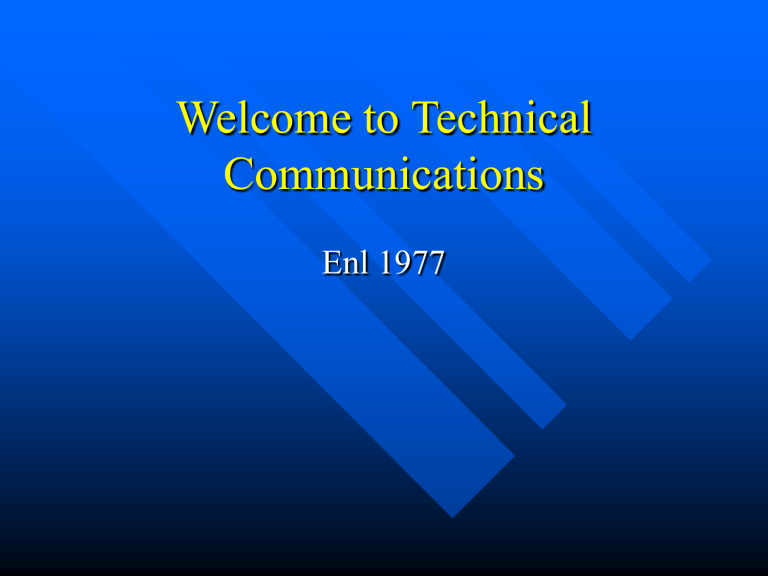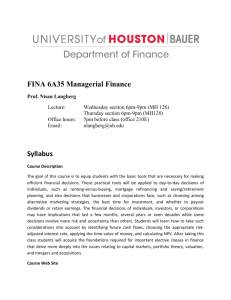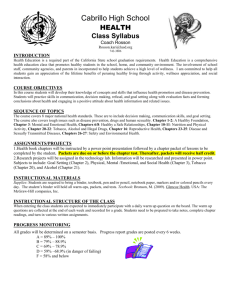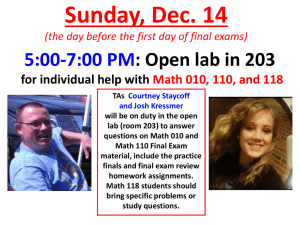Welcome - Algonquin College
advertisement

Welcome to Technical Communications Enl 1977 Overview Course structure Course schedule Student assessment Course policies Course Structure Unit One – Background knowledge and skills Unit Two – Collaborative writing Unit Three – Report writing Course Schedule Unit One: 5 weeks – Lessons 1, 2, 3, and 4—one week each – One week to prepare Project One Unit Two: 5 weeks – Lessons 5, 6, 7, and 8 --one week each – One week to prepare Project Two Unit Three: 3 weeks – Lessons 9 and 10 one week each – One week to prepare Project Three Student Assessment Project One: 15% Project Two: 15% Project Three: 20% Final Exam: 50% Course Policies Students must finish one unit before starting the next. Email is the “default” means of communication with me*. Communication, on my part, is reactive; if I don’t hear from you, I assume all is well. Late assignments must approved before the due date. Unit One: Details Lessons Assignments Project Due dates Unit One: Lessons Unit One will look at a series of exercises designed to build knowledge and skills in certain key areas: – – – – Site navigation Internet navigation Organization Writing mechanics Lesson One Blackboard (Bb) site navigation – Explore the Bb site to know where al the course elements are Classmates – Introduce yourself to the class and read about your classmates. Discussion Board – Understand how to use this important resource. Lesson Two Textbook introduction – Students will read the first two chapters of the textbook as an introduction to technical communication and writing strategies. Internet navigation and mapping – Using the “External Links” students will explore and organize Internet sites into a useful resource for use throughout the course. Lesson Three Syntax – A slide show presents some fundamentals and terminology used in analyzing the mechanics of writing. Semantics – Another slide show introduces the aspects of language associated with meaning. Lesson Four The products of technical communication – Chapters 8, 9, and 10 of the textbook are studied with a view to understanding the types of technical communication products: » Letters, faxes, memos and emails » Proposals » Reports Assignments: general considerations All quizzes in this course have three attempts. You must get 100% on the quiz by the third attempt to get any marks for it. Marks are tabulated as part of Project One. Unit One: 9 Assignments Lesson One – L1-a, L1-b, L1-c Lesson Two – L2-a, L2-b Lesson Three – L3-a, L3-b Lesson Four – L4 Lesson One: Assignments L1-a: there is a short Bb quiz (10 questions) based on the site content and navigation. L1-b: all students are asked to post a brief introduction on their student page. L1-c: the Discussion Board feature of the course site is explored here– you are asked to post a message and reply to one. Lesson Two: Assignments L2-a: There is a detailed quiz on chapters 1 and 2 of the textbook. It is designed to test student’s ability to re-read documents and notice details, rather than to test retention. L2-b: Students explore the External Links and organize them into a useful resource. The grammar sites, for example, will be needed for the next lesson. Lesson Three: Assignments L3-a: the syntax Bb quiz is difficult and involves unfamiliar grammatical terms. L3-b: the semantics Bb quiz is also difficult and could require Internet research to complete. You are also asked to read Chapter 5 as it will help with writing style. Lesson Four: Assignments L4: is a textbook Bb quiz based on chapters 8, 9, and 10. It is like the L2-a quiz, only longer. Unit One: Project One All the marks for the first unit are based on Project One. The project is a self-assessment report wherein students explain their progress in the first unit. The report combines review of the first unit, application of the skills learned, and development of strategies for success in the rest of the course. Unit One: Due Dates Lesson One: Jan. 23 Lesson Two Jan. 30 Lesson Three: Feb. 6 Lesson Four: Feb. 13 Project One: Feb. 20 NOTE: READ THE PROJECT ONE DESCRIPTION FIRST AND WORK ON IT CUMMULATIVELY. Unit Two: Details Lessons/Assignments Project Due dates Unit Two: Lessons Unit Two concerns collaborative writing. You will be assigned to a group of four students. Although it is a group project, all submissions and grades are individual. Each student is responsible for submitting six documents. Unit two: Documents Each student will submit an outline, a draft and a final copy of a summary of one of the four chapters in this unit (3,4,6, and 7). Each student will also submit a review of an outline, a draft, and a final copy of each of the other chapters respectively. Unit Two: Lesson Five This unit is based on chapters 3,4,6, and 7, and you should begin by reading them. L5-a: groups are required to decide which member will summarize which chapter and how the reviews will be delegated. L5-b: a group Chat session will be scheduled to finalize the delegation. Unit Two: Lesson Six L6-a: students write an outline of the chapter they are summarizing. L6-b: the outline is then sent to the delegated reviewer and one is received for review. It is important to read all four chapters so that reviews are well informed. Unit Two: Lesson Seven L7-a: once students have revised and incorporated reviewer’s suggestions, they write a first draft of their chapter summary. L7-b: the exchange procedure is repeated for draft revision: students send out their drafts to a different reviewer and receive a draft of a different chapter to review. Unit Two: Lesson Eight L8-a: Having examined the reviewer’s comments, students are ready to write the final copy of their respective chapter summaries. L8-b: This final copy is sent to yet a different member of the group to be proofread and a final copy is received for proofreading. Unit Two: Project Two All the marks for the second unit of the course are allocated in Project Two. Each of the six documents (the three phases of a chapter summary and the the three reviews) are all graded individually and each student is given a mark out of 15. Unit Two: Due Dates Lesson Five: March 6 Lesson Six: March 13 Lesson Seven: March 20 Lesson Eight: March 27 Project Two: April 3 Students are responsible for scheduling the revisions so that they can submit Project Two on time. Unit Three In this unit students combine the skills, knowledge and resources learned in the first two units and produce a presentation and a report. There are only two lessons in this unit. The first lesson is a tutorial on using PowerPoint, and the second involves the preparation of slides for a proposal. Unit Three: Lessons/Assignments There is no assignment associated directly with Lesson Nine L10: Students prepare five or six power point slides that outline their report for Project Three. Unit Three: Project Three Students submit a two-part report on plagiarism. The first part is the slides from Lesson Ten. These can be submitted at the same time as the report, giving students two weeks to prepare the project. The second part is the report itself. It is worth 20% of the final grade (15 for the report and 5 for the presentation) Unit Three: Due Dates Students should, at this point, have a good idea how long a report takes to prepare and are thus allowed to schedule the writing as they see fit, so long as they meet the Project Three deadline. Lesson Nine: April 10 (suggested) Lesson Ten: April 17 (suggested) Project Three: April 24 Final Exam The final exam will be scheduled with and written at your registering college. The exam is based on the textbook and students are responsible for all chapters including chapters 11 and 12 which should be reviewed before the exam.




